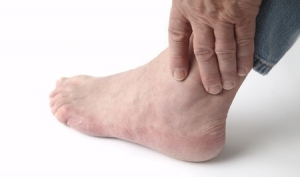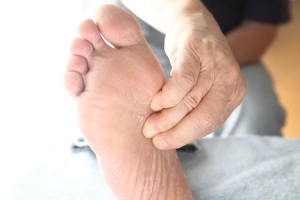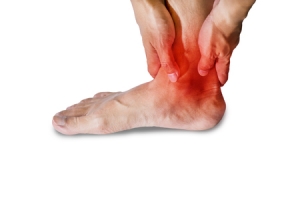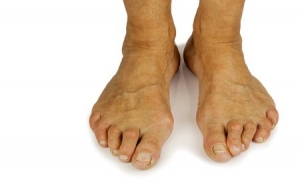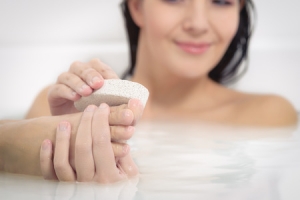Connect With Us
Blogs
Displaying items by tag: arthritis
Good Eats to Help Your Feet
In March, we celebrate National Nutrition Month. At Superior Foot & Ankle Care Center we believe that good nutrition has many positive benefits for your podiatric health. What’s the connection between what you eat and your feet? Read on.
Maintain a Healthy Weight—one of the most obvious benefits to eating healthy is getting to and then maintaining a healthy weight. Being overweight increases the risk and severity of many foot health problems, including:
- Arthritis
- Plantar fasciitis
- Flat feet
- Sesamoiditis
Many patients may not realize when it comes to your lower extremities, the pressure of excess pounds can be dramatic. For example, every pound you gain or lose exacts 4 times the amount of pressure on your knees.
Stay Active—in addition to the fact that it’s easier to be active when you’re not overweight, the foods you eat can also impact your energy level. Avoiding processed foods and those high in saturated and trans fats and sugars and focusing on lean protein and complex carbohydrates can increase your energy level and help you be more active.
Get the Nutrients You Need—good nutrition is about eating a varied diet. Enjoying a rainbow of produce, both fruits and vegetables will ensure that your body gets all of the many nutrients it needs. Certain fruits and vegetables like blueberries and red peppers can help fight inflammation, a common source of pain in podiatric disorders. Making choices that ensure you get the calcium you need from dairy products, leafy greens, and certain fishes will build strong bones—something that’s important to your feet since over a quarter of all the bones in your body can be found there.
Avoid Diseases that Harm Your Feet—your diet can lower your risk for certain diseases like diabetes, heart disease, and high blood pressure. Each of these conditions causes problems that can harm your feet such as poor circulation and neuropathy.
If you have questions about ways that your diet can improve the health of your feet, contact our Long Beach office by calling: (562) 420-9800. Our podiatrists, Dr. Victoria Foley, and Dr. Constance Ornelas. We want to help our patients be proactive about their health and take the necessary steps to lead active lives.
Arthritis Comes in Many Forms
Arthritis is a term that is used to describe over 100 different joint conditions. At Superior Foot & Ankle Care Center we think it’s important for our patients to be informed about arthritic conditions—especially since each of your feet has 33 joints that need to be protected for your foot to function properly.
Although different types of arthritis may have different causes and manifestations, there are some common characteristics. These include:
- Joint pain
- Swelling
- Stiffness
- Limited range of motion
- Redness or heat in a joint
Some of the more common types of arthritis include:
Osteoarthritis—this is the best-known type of arthritis. Also known as “wear and tear” arthritis, it occurs over time as cartilage breaks down with age and use. Osteoarthritis usually comes on gradually and gets worse over time. Being overweight can exacerbate osteoarthritis because of the excess pressure on the joints caused by carrying extra weight.
Rheumatoid arthritis—although rheumatoid arthritis shares the symptom of joint pain with other forms of arthritis, this form of the disease is far more serious in that it is part of a chronic inflammatory system of diseases that can affect various systems of the body including lungs, heart, eyes and nervous system.
Traumatic arthritis—an injury or trauma to a joint such as a bad sprain, fracture or being hit with a heavy object can damage cartilage and lead to arthritis.
Gout—this form of arthritis occurs when uric acid builds up in the joint and then crystallizes, causing severe pain, inflammation and swelling. Gout most often affects the big toe joint and can be triggered by certain foods, such as shellfish, red meat, organ meats, red wine, brandy, and other alcoholic beverages.
Psoriatic arthritis—in some people with the skin condition of psoriasis a form of arthritis may develop as well. Arthritis may be mild and tends to get worse when the skin condition worsens.
With any form of arthritis, early detection and treatment is key to slowing the progression of the disease and managing the symptoms. If you have any signs of joint disease, it’s important that you contact our Long Beach office (562-420-9800) as soon as possible so that one of our podiatrists, Dr. Victoria Foley or Dr. Constance Ornelas can determine the source of your joint discomfort along with the appropriate treatment.
Could You Have Metatarsalgia?
Are you experiencing acute pain in the ball of your foot? Is the pain more noticeable with increased activity or when you are walking barefoot? Have you noticed a callus beginning to form in the spot where the pain is? If you answered yes to one or more of these questions, you may be suffering from a condition we treat at Superior Foot & Ankle Care Center known as metatarsalgia.
Your metatarsal bones run down the middle of your foot from your ankle to each of your 5 toes. When the nerves between two of the metatarsals become inflamed, it causes pain, and this is known as metatarsalgia.
What’s Behind the Pain
Basically, metatarsalgia occurs when there is either too much pressure or an uneven pressure applied to the metatarsals. This can have a wide range of causes, however, including:
- Overpronation
- Arthritis
- Foot injuries
- Aging
- Weight gain
- Overuse from weight-bearing sports such as running
- Foot deformities
- Morton’s neuroma
- Poorly fitting footwear
- Standing for long periods on hard surfaces
Getting Relief
The treatment for metatarsalgia will depend on the cause. The first step is to have our podiatrists, Dr. Victoria Foley and Dr. Constance Omelas examine your feet. The foot doctor will also want to get your medical history and ask about your recent activities. Once the reason behind the metatarsalgia has been found, the foot doctor may recommend one or more of the following:
- Icing the area and taking over-the-counter anti-inflammatory medications to relieve pain and inflammation
- Resting your feet from sports and physical activities that aggravate the ball of the foot
- Custom orthotics to correct overpronation or other biomechanical issues
- Wearing properly fitting, supportive shoes
- Losing weight if you are overweight to reduce pressure on your feet
If you are experiencing pain or pressure in the ball of your foot, contact our Long Beach office today for an appointment by calling: (562) 420-9800.
Eat This Not That for Less Joint Pain
World Arthritis Day takes place in October and here at Superior Foot & Ankle Care Center, we’d like to take this opportunity to explore the relationship between food and joint health. Overall, we know that maintaining an appropriate weight greatly reduces the strain on your joints (and the rest of your feet), lowering your risk for arthritis and other foot problems. Below are some foods to choose or stay away from if you suffer from arthritis or other joint conditions:
Eat These:
Fish high in omega-3 fatty acids. These include salmon, sardines, tuna, anchovies, scallops and other cold-water fish. Omega 3’s have inflammation-fighting properties and research has shown that people who consume the highest amounts of them have the lowest levels of two inflammatory proteins in their bodies. If you can’t stand fish, take a fish oil supplement. A recent study found that 600-1,000 mg per day could ease joint swelling and pain and reduce the duration of morning stiffness in rheumatoid arthritis sufferers.
Fruits and Vegetables. Eating a rainbow of produce will give you many nutrients and antioxidants. Among the heavy hitters for reducing inflammation are: citrus fruits, red and purple fruits such as blueberries, strawberries and cherries and dark greens like spinach, kale and broccoli.
Good oils. Of course, all oil should be used in moderation but 2-3 tablespoons of olive oil a day can help reduce joint pain because it contains a compound that has properties similar to that of nonsteroidal, anti-inflammatory medications. Other “good oils” include safflower and avocado oil and also walnut oil which is high in omega 3’s.
Skip These:
Sugar. Foods with processed sugars (cakes, cookies, candy bars, sodas and fruit juices) release messengers called cytokines that actually create an inflammatory response in the body. Read labels because sugar has many names. Anything ending in “ose” is usually a sugar.
Saturated and Trans Fats. These trigger fat tissue inflammation which not only worsens arthritis but is an indicator of heart disease too.
Mono-sodium glutamate (MSG). Although most often found in prepared Asian foods and soy sauce, MSG is also added to many fast foods, soup mixes, salad dressings and deli meats. MSG opens 2 pathways to chronic inflammation.
Food is just one way to help control arthritis. If you are experiencing pain, stiffness and/or swelling of the joints in your feet and ankles, contact our Long Beach office by calling: (562) 420-9800. Our podiatrists, Dr. Victoria Foley or Dr. Constance Omelas will examine your feet and help develop a plan to best deal with your joint issues.
Do’s and Don’ts for Reducing Risk of Childhood Obesity
At Superior Foot & Ankle Care Center we treat many conditions that are made worse by the patient being overweight. The risk and severity of arthritis in the feet and ankles, metatarsalgia and flat feet, for example, are all increased by obesity. In addition, being obese increases the risk for diseases like diabetes and hypertension, which also have serious health consequences for your feet. September is National Childhood Obesity Awareness Month. Studies have shown that obese children tend to continue to be obese as adults. For that reason, it’s important to foster healthy lifestyle habits during childhood. Below are some do’s and don’ts to help your child maintain a healthy weight:
Do: strive to have your child spend at least 60 minutes a day being physically active. Encourage them to participate in a wide variety of activities to be sure they get exercise that is aerobic, muscle and bone strengthening. Not all activities have to be organized. Just playing in the yard children are likely to run, jump and climb which will give them all the types of exercise they need.
Don’t: force your child to be active if they complain of foot or ankle pain. If you suspect a podiatric problem is sidelining your child from being physically active, contact our Long Beach office (562-420-9800) for an appointment. Our podiatrists, Dr. Victoria Foley and Dr. Constance Omelas will examine your child’s feet to determine if there is an injury or other disorder that is causing them pain.
Don’t: allow unlimited amounts of time spent in front of a screen. If your child has full-time access to cell phone, television, computer and video games they are less likely to engage in physical activities.
Do: make changes in your family’s eating habits. Increase the number of fruits and vegetables in your menus, replace sugary drinks with water and have healthy snacks readily available. Involve your children in menu planning and grocery shopping and teach them how to make good food choices.
Do: set a regular bedtime for your child or teen that allows them to get enough sleep. Depending on your child’s age, they may need between 8 and 12 hours of sleep per night. Studies show that lack of sleep increases the risk of obesity.
Approximately 1 in 5 children today are obese. Working together, families and communities can help greatly reduce this number with lifestyle choices that will make for healthier children and, ultimately, healthier adults.
Are You Plagued by Weak Ankles?
Do you constantly feel like your ankle is going to “give out?” Does walking on uneven surfaces, in high heels or stepping off a curb frequently cause your ankle to turn? If so, you may be suffering from chronic ankle instability, a condition that we at Superior Foot & Ankle Care Center know many patients find very frustrating.
Causes of Wobbly Ankles
In nearly all cases, at the root of a weak ankle condition is a previous ankle injury or problem. Common sources include:
- One or more ankle sprains
- Scar tissue formation following a sprain
- Fracture in the ankle joint bones
- Arthritis or other inflammatory condition of the ankle joint, tendons or joint lining
- Nerve damage in the ankle area, such as stretching, tearing or pinching of the ankle nerves
Sometimes patients fail to complete the full course of rehabilitation for an ankle injury. Physical therapy and other treatments are geared toward healing the overstretched ankle ligaments and also strengthening the muscles that surround the ankle. When the pain stops, that’s when a patient stops therapy. Unfortunately, that doesn’t mean the ankle is fully healed. Going back to normal activities can lead to another sprain because the ankle is still weak. The more injuries, the weaker the ankle becomes.
Breaking the Cycle
The first step is getting your ankles evaluated. Our podiatrists, Dr. Victoria Foley or Dr. Constance Omelas will examine your ankles and feet. The foot doctor will also ask questions about previous injuries, your medical history and recent activities. Digital x-rays (which can be done right in our Long Beach office) and/or other imaging studies may also be ordered to help get a clear picture of the condition of the ankle bones and joints.
Depending on the cause and extent of the ankle damage, a treatment plan will be developed which may include:
- Anti-inflammatory or steroidal medications prescribed on a temporary basis to decrease swelling
- Ankle braces or supports
- Immobilizing the ankle area if there is a fracture that needs to heal
- Physical therapy to strengthen and improve range of motion for ankle muscles
If you have weak ankles, don’t wait to get treatment. Contact us today by calling (562) 420-9800.
Questions about Bunion Surgery
Bunions are a condition that we at Superior Foot & Ankle Care Center treat often. A bunion is a deformity of the toe joint that most often affects the big toe. It causes the joint to move out of place and drift toward the second toe. Bunions can have a number of different causes, including:
- Neuromuscular problems
- Flat feet
- Recurring stress to the foot
- Congenital defects
- Previous injury
- Arthritis
- Ill-fitting footwear
Bunions are a progressive disorder, which means they will continue to get worse over time. Our podiatrists, Dr. Victoria Foley or Dr. Constance Omelas will start by doing a complete physical examination of your feet. While conservative measures are always preferable, if your bunion has progressed to the point where it is impeding your ability to wear shoes and walk without pain, surgery may be the best treatment option. Below are some questions to ask before scheduling bunion surgery:
What type of bunion surgery do you recommend? There are several different kinds of bunionectomies. The foot and ankle surgeon will choose the type that best addresses the structural changes that have occurred to your toe because of the deformity. Ask the podiatrist to thoroughly explain the surgical procedure and ask questions if there is anything you don’t understand.
Where will the surgery take place? Bunion surgery is usually performed on an outpatient basis under local anesthesia. It will be necessary to have someone drive you home so be sure to arrange for that before the date of the surgery.
What will the recovery be like? You will have to avoid bearing weight on the affected foot for some period of time after the surgery. Ask the foot doctor how long you will need to be out of work. In addition, you’ll want to know how much discomfort to expect post operatively. Even after you are able to bear weight and return to work, you may need to do physical therapy or use a custom orthotic. Find out what results the podiatrist expects from the surgery and what the post-surgical treatment plan will consist of.
Knowing what to expect for your bunion surgery will reduce worry and help you better prepare for the modifications to your schedule. If you have additional questions, don’t hesitate to contact our Long Beach office by calling: (562) 420-9800.
June is Older Americans Month
At Superior Foot & Ankle Care Center we know that foot care needs change as you age. This week we’d like to address some foot health care needs that are particularly important for our more senior patients in honor of Older Americans Month.
Work with Your Podiatrist—there are several foot ailments that are more likely to develop as you age, such as arthritis and certain nerve issues. Your feet may also be the first place that systemic disorders such as diabetes or circulatory dysfunction show up. For these reasons, it’s important to maintain a regular schedule of checkups with our podiatrists, Dr. Victoria Foley and Dr. Constance Omelas. This will enable the foot doctor to spot changes in your feet and also help you manage chronic foot issues and keep them from becoming debilitating.
Shoe Sense—good shoes are important at any age but for senior patients, the right shoe can prevent falls and keep foot disorders from worsening. Have your foot professionally measured at a quality shoe store. It is not unusual for your shoe size to increase as you get older. Buy shoes that have good arch and ankle support and a gripping tread on the bottom. Shoes with laces give a better fit than Velcro. For dress shoes, keep heels to no higher than 2 inches. Replace shoes when they become stretched out or damaged.
Develop a Daily Foot Care Regimen—wash your feet every day and dry completely. Check your feet for any changes in skin or nails, cuts, bruises, growths or any other unusual symptoms. Keep toenails trimmed straight across and not too short to avoid ingrown nails. Apply moisturizer or foot powder as needed.
Good Habits for Life—many of the lifestyle choices that are healthy for the rest of your body have a positive impact on your feet too. Don’t smoke—it impedes circulation. Exercise regularly to increase bone strength and maintain range of motion. Keep your weight down because extra pounds put more stress on joints and bones in your lower extremities.
Keeping your feet healthy during your senior years isn’t difficult. To learn more about how to ensure that your feet will enable you to live a long, active life, contact our Long Beach office by calling: (562) 420-9800.
5 Ways to Take Better Care of Your Feet
At Superior Foot & Ankle Care Center we believe in being proactive when it comes to the health of your feet. In honor of Foot Health Awareness Month, we’d like to offer the following tips for taking care of your feet:
- Wear shoes that fit. This is one of, if not the single biggest steps you can take to prevent foot and ankle injuries and disorders. Some studies have shown that up to 90% of people are wearing shoes that are the wrong size! Shoes that are too narrow or tight in the toe box can encourage deformities such as bunions and hammertoes as well as increase the risk of ingrown toenails and fungal infections. Get your foot professionally measured at the shoe store. Shoe size can change as you age and during pregnancy.
- Get in the habit of doing self-exams on your feet. Changes in the skin or nails of your feet, as well as shape, size or color, can all be indicators of potential foot problems. Any differences in sensation (burning, numbness, tingling), swelling or abnormal growths should be reported to our podiatrists, Dr. Victoria Foley and Dr. Constance Omelas promptly. Early detection of a foot problem can mean a better outcome and less invasive treatment.
- Limit time going barefoot. Bare feet in public places are at a higher risk for coming in direct contact with fungi and bacteria that cause infections such as athlete’s foot and fungal toenails. Even at home, however, going barefoot increases your risk of puncture wounds and injuries.
- Don’t neglect foot hygiene. Basic daily care of your feet should include washing with soap and water (and drying completely) as well as applying foot powder or moisturizing lotion, depending on your individual needs. Don’t wear socks more than one day and alternate our shoe choice as well.
- Live a Healthy Lifestyle. You may not think about it but maintaining a healthy weight, exercising and getting regular checkups all contribute to the health and well being of your feet. Be sure that you monitor chronic diseases such as diabetes and arthritis and follow your physicians’ instructions for keeping this conditions under control.
If you have questions about how to best care for your feet, contact our Long Beach office by calling: (562) 420-9800.
3 Ways that Food Affects Your Feet
At Superior Foot & Ankle Care Center we know that the condition of your feet isn’t just about what goes on below your knees. Our podiatrists, Dr. Victoria M. Foley and Dr. Constance Ornelas believe that the health of the rest of your body plays a significant role in podiatric concerns. In honor of National Nutrition Month, we want to highlight the importance of proper eating and how it relates to your feet. Below are 3 ways that your diet can improve the health of your ankles and feet.
- Avoid Diabetes—diabetes, which afflicts over 30 million people in the U.S., affects your body’s ability to properly use or produce insulin resulting in high blood sugar levels. Diabetes reduces circulation and can cause neuropathy (loss of sensation) leaving your feet vulnerable to wounds and ulcers that can lead to infections and even possible amputation. The good news is you can prevent or significantly delay the onset of the most common form of this disease, Type 2 diabetes, with physical activity and modifications to your diet, including:
- Cutting way back on foods high in added sugar such as sodas and refined, processed foods
- Increasing the number of fruits, vegetables and whole-grain foods you consume every day
- Switching to healthier sources of fat such as olive and canola oil, nuts and avocados and avoiding saturated fats
- Prevent Gout Attacks and Inflammation—for patients who suffer from gout food is often what triggers an attack. Avoiding shellfish, red meat, beer, red wine, organ meats and heavy sauces can help you steer clear of this extremely painful joint inflammation which often happens in the big toe or ankle. Inflammation in, general, can be reduced by eating more berries, fish, and nuts high in omega 3 fatty acids, green vegetables, and olive oil, while steering clear of white sugar, fried food and refined flours.
- Decrease Your Risk of Foot Disorders—what do arthritis, plantar fasciitis, stress fractures and flat feet all have in common? The risk of developing one of these podiatric disorders as well as the severity of their symptoms are all increased by being overweight. There are many strategies for reducing and maintaining a healthy weight:
- Using smaller plates to automatically reduce portions
- Consulting a nutritionist or registered dietician to develop a healthy food plan
- Eat smaller portions more frequently instead of big meals
If you have questions about how changing your diet could impact a chronic foot condition contact our Long Beach office at 562-420-9800.

